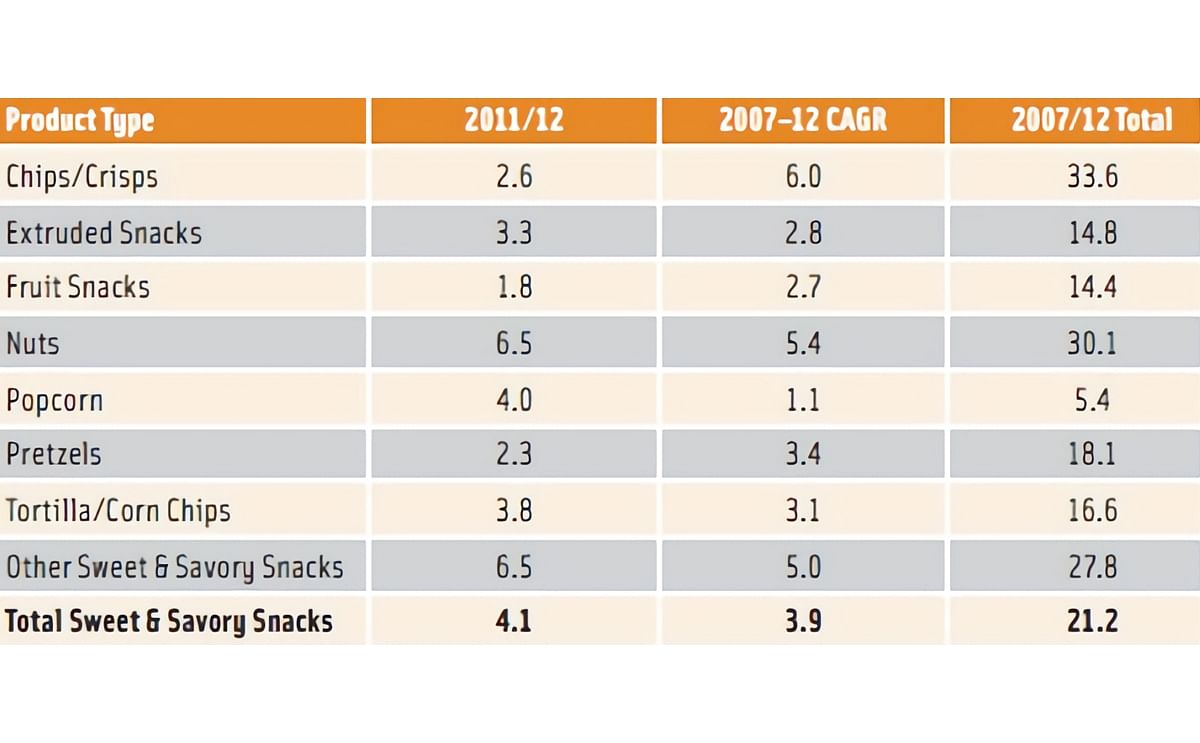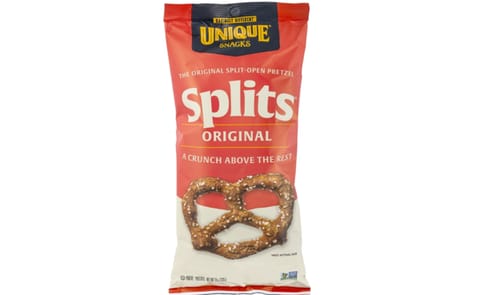Sweet and savory snacks experienced a 4% current value growth in the United States in 2012, according to research from Euromonitor International (Graph above: % value growth by savoury snacks Category). Such growth is a positive for snack producing companies and the category is expected to see compound annual growth rates (CAGRs) of 2% and 1% in constant value and volume terms, respectively, over the forecast period to exceed $38 billion by 2017.
Euromonitor categorizes the “Sweet and Savory Snacks” category as the aggregation of fruit snacks, chips/crisps, extruded snacks, tortilla/corn chips, popcorn, pretzels, nuts, and other sweet and savory snacks. Products that fall into the other category include sunflower seeds, fruit and nut mixes/trail mixes, seaweed snacks, meat snacks, fish snacks, and pork scratchings (pork rinds).
Key Growth Drivers
Sweet and savory snacks continue to see strong growth rates across nearly all of its various categories, driven by the rapidly expanding trend of eating between meals, especially among Millennials (generally defined as 18-34-year-olds).
Another contributing factor is continued flavor innovation that consistently matches the taste preferences of younger Millennial consumers, who prefer bolder, spicier flavors than their parents. Finally, the ability of new products to position themselves as a healthy or relatively low-calorie option for hunger cravings between meals has proven to be very effective in attracting dieters or other health-conscious consumers.
According to Euromonitor, health-positioned items have returned to the forefront of growth for snack products. New products such as Popchips and Skinny Pop have proven to be incredibly fast growing brands in their respective categories, and both these brands have largely stressed the relative healthiness of their products compared to their competitors.
Competitive Landscape
According to Euromonitor research, variety and unique flavoring appear to be the key to success for many companies. Many younger and older consumers are increasingly demanding variety in their snacks to ensure that snacking does not become boring. Therefore, companies which have attempted to increase or change their flavor offerings have done much better, such as Diamond Foods’ Kettle Chips with its limited re-release of four of its most popular flavors of the past two decades. In addition to variety, many companies have increased the intensity of many of their flavor offerings to attract younger consumers. For example, Frito-Lay released Doritos Dinamita in March 2012, which comes in spicier flavors such as Chile Limon and Nacho Picoso.
PepsiCo Inc.’s Frito-Lay Co. division continues to lead the sweet and savory snacks category, commanding a value share of 42% in 2012. The company remains the leading player in chips/crisps, extruded snacks, tortilla/corn chips, and other sweet and savory snacks and has recently started a push to validate and label some of its own products as gluten-free. In addition, the company continues to leverage the brand equity of its major snack brands in foodservice channels, such as the release of Doritos Locos Tacos at Taco Bell in March 2012.
With the purchase of Pringles from Procter &Gamble, Kellogg Co. has achieved by far the biggest increase in share, moving from less than 1% to nearly 3% in 2012. In 2011, Procter &Gamble was in talks with Diamond Foods to acquire the Pringles brand, but due to an accounting scandal on the part of Diamond Foods the deal was cancelled. Kellogg Co. agreed in February 2012 to purchase Pringles for $2.7 billion. The company felt that Pringles would fit well with its other lines of snacking brands, such as Sunshine Cheez Its and Special K Cracker Chips.
Looking Ahead
Sweet and savory snacks are projected to record CAGRs of 2% and 1% in constant value and volume terms, respectively, over 2012–2017. With the trend of snacking between meals likely to continue among younger consumers, the category will remain incredibly prevalent in U.S. eating habits. In addition, manufacturers will continue to compete with each other by improving both the flavor and health attributes of many of their brands as consumers now demand both from their snack products.
Solid Sales Value Growth in US Savory Snacks Market

Like to receive news like this by email? Join and Subscribe!
Get the latest potato industry news straight to your WhatsApp. Join the PotatoPro WhatsApp Community!
Highlighted Company
Sponsored Content
Sponsored Content
Sponsored Content
Sponsored Content
















